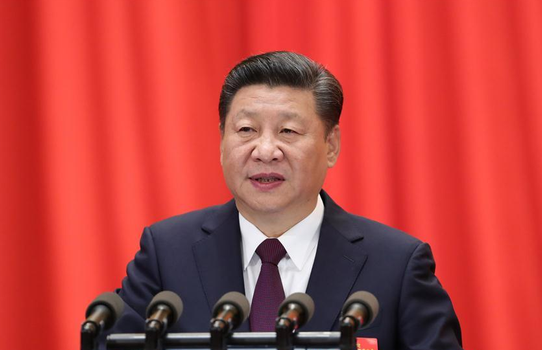
Xi Jinping Presides Supreme Over Start of 19th Party Congress
Publication: China Brief Volume: 17 Issue: 13
By:

China’s 19th Party Congress is now in full swing. On August 18, Communist Party General Secretary Xi Jinping started the once-every-five-years meeting with a sweeping party work report laying out his accomplishments and plans for the future. While the Congress will see important changes in key leadership posts, the work report acts as a capstone to the preceding five years.
Acknowledging the transformation of China underway and internal and external challenges facing the state, Xi presented his case that under his administration China has made important strides toward achieving the “Great Rejuvenation of the Chinese People” (中华民族伟大复兴) (Xinhua, October 18).
While the three-and-a-half hour, 30,000-Chinese-character speech will be distilled and digested for months to come, a few broad themes are worth highlighting.
A core part of Xi’s public image is his perception as a man of the people and champion of the countryside. This is not pure populism—rural poverty and growing social inequality are among the Chinese Communist Party’s (CCP) most pressing issues. In the run-up to the Congress, hagiographic documentaries and books appeared discussing Xi’s time as a “sent-down youth” (urban citizens and intellectuals sent to the countryside to learn from peasants). As General Secretary, Xi has made poverty alleviation (扶贫) a priority. The country currently suffers from rising inequality, particularly in the countryside. One reason for this is education gap between rural and urban areas. According to research by Stanford Universities’ Rural Education Action Project, three-fourths of the country’s young people lack a high-school education (CSIS, September 14). Nevertheless, as previewed at the annual Chinese Poverty Alleviation International Forum in May, the Chinese government intends to eradicate poverty by 2020 (China Brief, June 9). Xi’s speech was peppered with references to the program and the success of “moving over 60 million people out of poverty…and reducing the incidence of poverty from 10.2 percent to less than 4” (Xinhua, October 18).
Based on the Party Work Report the CCP clearly views development, managing social unrest and emerging non-traditional security threats as priorities on par with traditional security issues, as embodied in the “Comprehensive National Security Outlook” (总体国家安全观). The underpinning idea “unifies development and security” and “external and domestic security” (Xinhua, October 18).
As frequently argued in this column, one noteworthy component of the “Outlook” is food security—ensuring sufficient domestic food supplies. Food security is emblematic of Xi’s policies that link trade (such as grain imports from Russia), land reform (such as the program to increase the size of farm plots for greater efficiency) and the environment (addressing China’s soil toxicity problems) with broader concerns about the vulnerability of China’s sea lines of communication (China Brief, March 2; July 1, 2016; March 8, 2016). Taken together, these policies will allow, in Xi’s words “China to firmly grasp its rice bowl in its own hands” (Xinhua, October 18).
To ensure China’s future growth it is not enough to address internal economic and environmental problems. Ensuring China’s sea lines of communication are secure and growing China’s trade abroad has led Xi to set ambitious goals for foreign policy and military reform.
While Xi’s high-profile visits abroad may have lacked some of the novelty of Deng Xiaoping’s first tours abroad in the late 1970s and early 1980s, Xi’s shuttle diplomacy has the hallmarks of a mature power that his predecessors lacked. Befitting this new era in foreign relations, Xi’s three major contributions—“Great Power Politics With Chinese Characteristics” (中国特色大国外交) and the “New Type Great Power Relations” (新型国际关系) and “One Belt One Road” (一带一路)—will continue to set the tone for the next five years. However, as Chinese promises of loans fail to materialize or partnerships sour, this is the aspect of Xi’s legacy that is most likely in peril (EDM, June 6; China Brief, June 21, 2016).
Conversely, the military reforms announced at the end of 2015 will likely be a cornerstone of Xi’s legacy. The formation of new theater commands, and the more recent “below the neck reforms” at the individual unit level can fairly be described as “historic breakthroughs” (Xinhua, October 18). While training and aspects of the People’s Liberation Army’s organizational structure continue to be barriers to greater effectiveness, Xi has laid the groundwork for achieving the “Dream of a Strong Military” (强军梦).
Though Western media tends to fixate on Chinese military developments, it is worth keeping in mind the most important strategic direction for the CCP is not North, South, East or West, but inward—maintaining its power and ensuring domestic stability.
This focus on domestic security has led China under Xi to develop the world’s largest surveillance state. Tested in China’s traditionally more restive minority regions in the west, surveillance cameras linked with artificial intelligence and “social credit” databases are being rolled out nation-wide (China Brief, July 21; September 21). After decades of theorizing about such a state under the rubric of “social management” (社会管理), the CCP appears to be on the brink of perfecting the modern panopticon (China Brief, August 17).
China is deservedly proud of its modernization, economic wealth and scientific progress. The CCP is clearly focused on ensuring that it remains at the crest of the wave of power and influence it has ridden as China’s global power expanded after the Reform and Opening. China under Xi Jinping and the Party apparatus is clearly at its strongest point in several hundred years. Xi’s influence is such that his core ideology has been elevated to same status as that of Mao Zedong. Nevertheless, as Xi and his political allies continue to build higher and higher walls it remains to be seen where the cracks will begin to emerge.




